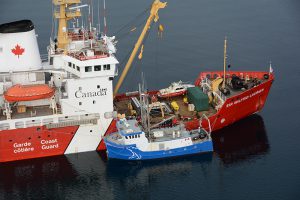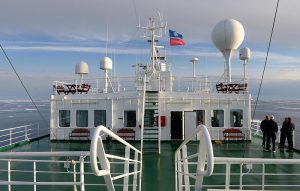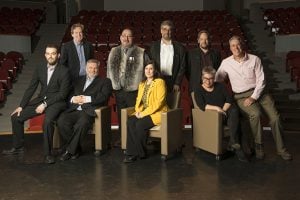
History
2014 Victoria Strait Expedition
This year's search is about much more than underwater archaeology. The Victoria Strait Expedition will contribute to northern science and communities.
- 1205 words
- 5 minutes
This article is over 5 years old and may contain outdated information.
History

September 16, 2014, 22:15 Mountain Standard Time
Each year that we’ve done this mission, we’ve had a talk with our crew and the partners aboard to discuss what we would do if we found something. All I can say is: be careful what you wish for. Because when it happened, it happened fast and events rapidly overtook us. Several personal commitments, including my “Captain’s logs,” were shelved temporarily as we worked to keep up with rapidly changing objectives.



September 1 started like most of our days, with a 7 a.m. morning briefing to formulate the day’s plan. As the fog, winds and other conditions are unpredictable up here, trying to plan even the night before is often a wasted effort. This day looked great for flying, so helicopter time was assigned to the Canadian Hydrographic Service’s Scott Youngblut so that he could set up a GPS reference station on shore. The Nunavut archeology team of Douglas Stenton and Robert Park jumped at the chance to join Youngblut in the chopper’s extra seats for a flight over to land. Add to this situation a pilot, Andrew Stirling, with keen eyesight and a budding interest in archeology, and you have the start of our great adventure.
I can still clearly remember the smirk on the faces of Stenton and Park when they stepped out of helicopter upon their return to the ship. As a standard ritual, I have always met them on the flight deck after they return from a survey just in case they’ve found something new. Stenton whispered to me “I’ve got something cool to show you,” although I couldn’t see anything as his new finds were hidden away in the helicopter. Within half an hour, Stenton retrieved his items and carried them to the ship’s bridge where they caused a lot of immediate excitement.
Stenton showed me the iron fitting first. And then I saw the broad arrows. I knew instantly that they were on to something big. Because I have a classic boating background, I’ve walked over many wood sailing ship hulls in my life and I quickly considered which part it could be. I raced down to my cabin to look at the ship plans for Terror and Erebus to see if I could identify it. At the same time Parks Canada’s Jonathan Moore was doing the same, and he located it just minutes before I had (those guys are really good!). It was an iron fitting from the base of a davit. Even to my amateur eye it was obvious that this was the “real deal.” What an extraordinary find for the Government of Nunavut!
As always, we stuck to the plan that had been developed in advance for just this type of find. The first joint news release by the Government of Nunavut and the federal government was issued on September 8 and outlined the key details of the first clues found on land.
The next big wave would follow later, as Parks Canada’s team followed up on the vital clues located by the Nunavut archeology team. The next chapter then suddenly shifted to Parks Canada’s team aboard the Investigator (coincidentally named for Captain Robert McClure’s ship which was abandoned in 1853 in Mercy Bay while also trying to solve this mystery).
Parks Canada’s archeologists kept their find from me until one evening when they called me into my own cabin and shut the door behind me. If you know anything about ships, you’ll know that this is extremely unusual. I had no idea what had happened and I actually feared the worst. As I sat next to my bookshelf filled with nautical history, they let me in on their astonishing secret. They had found one of the ships! They showed me the recording of the side-scan image, and as I watched it scroll by I felt like I was watching it live.
I was overwhelmed. It took a few minutes to sink in. But after the tears and hugs, we resumed our mission as we are so apt to do after years of being on this hunt. We had a clear contingency plan that was used to guide our next steps. We unplugged the ship from the world, briefed the crew on the story and then set to work to confirm the discovery with Parks Canada’s remotely operated vehicle. Nature tried to stop us with high winds, but we pushed on and the underwater archeologists gathered the visual evidence they needed. We definitely found one! We just don’t know which one.
On September 9, the Prime Minister would proudly release a formal statement about our well-kept secret to Canadians and the world, and a technical briefing would give the world access to our inside story.
This story is so much bigger than any of us, and that any attempt to describe it in my log would take away from those who have worked hard for many years to make this happen. It is a true honour to be have been among this extraordinary group during this expedition, many of whom who have been deeply dedicated to this work for years and have faced many challenges and criticisms along the way.
One of the greatest honours for me took place on September 10 when I was invited to address the council in Gjoa Haven, along with the federal Minister of the Environment, the Honourable Leona Aglukkaq, the Premier of Nunavut, the Honourable Peter Taptuna, the Nunavut Minister of Finance, the Honourable Keith Peterson, and the mayor of Gjoa Haven, His Worship Allen Aglukkaq. Following that meeting, the hamlet held a community feast and put on a true northern celebration that included speeches, singing and drum dancing.
As the celebration went on, I realized that this honour truly belongs to the Inuit. Over the years, I have read many accounts of the oral history, and I have been fortunate in being able to speak to many residents of Gjoa Haven. In particular much credit goes to Louie Kamookak, a local well-respected Franklin historian. The Inuit stories held true.
Since this project began in earnest in 2008 (when making our own charts was needed simply to get into this area), the specialized knowledge, talents and skills of those aboard have been shared freely. In hindsight, this resulted in a scenario where pilots became archeologists; hydrographers became historians; professional mariners became hydrographers; archeologists and ship captains became diplomats; and all aboard became aware of the significant value of Inuit traditional knowledge.
Lastly, I’d like to toast Lady Franklin for spearheading many of the early search expeditions and leaving a legacy for us to follow. I’m so glad we could help.
Are you passionate about Canadian geography?
You can support Canadian Geographic in 3 ways:

History
This year's search is about much more than underwater archaeology. The Victoria Strait Expedition will contribute to northern science and communities.

History
Introductory insights into the Canadian Coast Guard’s role in the search area

History
First official day of the 2014 search for Sir John Franklin’s lost ships

People & Culture
On April 12, Franklin enthusiasts had a rare opportunity to come together in the same room as The Royal Canadian Geographical Society presented their 2016 Can Geo Talks